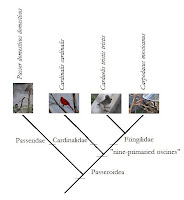 |
| From ART Evolved: Life's Time Capsule. |
Pages
▼
Tuesday, January 31, 2012
Feathered dinosaurs; no excuses!
Monday, January 30, 2012
Draw A Dinosaur Day 2012!
 |
| Monday speed sketch of "Dave" for "DADD". |
Virtual Birding Roundup (Part 3)
 Alright, boys and girls. I started this little endeavor a month ago. It's time to bring it all together, once and for all. So far in our virtual birding roundup, we've spent the last two parts talking about various families within the order Passeriformes. Which makes sense considering that there are over 100 different passerine families, and they contain more than half of all known bird species (Mayr, 1946). For the most part, the relationships between these families were traditionally defined by morphological characters, and were believed to be fairly well understood. But recently, more and more molecular analysis has begun to show a different phylogeny; one that we still don't have a full picture of. And that's where the next bird from our quiz comes in.
Alright, boys and girls. I started this little endeavor a month ago. It's time to bring it all together, once and for all. So far in our virtual birding roundup, we've spent the last two parts talking about various families within the order Passeriformes. Which makes sense considering that there are over 100 different passerine families, and they contain more than half of all known bird species (Mayr, 1946). For the most part, the relationships between these families were traditionally defined by morphological characters, and were believed to be fairly well understood. But recently, more and more molecular analysis has begun to show a different phylogeny; one that we still don't have a full picture of. And that's where the next bird from our quiz comes in. |
| Regulus calendula |
Saturday, January 28, 2012
Happy "Capitalsaurus" Day
When most people think of the District of Columbia, they think of politicians, monuments, and busy city streets. But underneath the modern sprawl lies the remains of plants and animals that lived millions of years ago. And sometimes, we are lucky enough to find them. That's exactly what happened with "Capitalsaurus".
 |
| The "Capitalsaurus" discovery site, located in Garfield Park at the 100th block of F Street, SE, and named "Capitalsaurus Court" on January 28, 2000. Photo by Nicholas Clark from Wikimedia Commons. |
Wednesday, January 25, 2012
Virtual Birding Roundup (Part 2)
After a pretty positive response to "Part 1", I headed out of town and the roundup got interrupted. Now Jenn Hall (who did a pretty great job of guessing honestly in my original post) would tell me to put some pants on and stop apologizing. And I'm not gonna lie, that's pretty sound advice. So technically I'm not going to apologize. And I am going to wear pants. But I am also going to get this roundup going again. If I'm not mistaken, we left off with the Passeroidea, the monophyletic grouping of "sparrow-like" birds. Where should we go from here?
Monday, January 23, 2012
Four Critters
A little over a week ago, I posted a ridiculously low quality image of the Spring Run at Florida's Blue Spring State Park, and told you all there were four critters in it. As ambiguous as it was, I swear, they are actually there. Take another look. Here is the huge version that hangs off the page. Click it for a cleaner view.
Saturday, January 14, 2012
Winter Migration
Like many of my avian cousins, I've migrated south this winter. As you may already know (if you follow me on Twitter) I'm currently in Florida at Blue Spring State Park, accompanying a group of University of Maryland students on their Alternative Break trip. As soon as we got to the park, I immediately started taking photos, and when I get home and have a more reliable internet connection, I'll be sure to upload a bunch of them.
But for now, I'll leave you with this. There are four critters hiding somewhere in the photo. Can you find them?
But for now, I'll leave you with this. There are four critters hiding somewhere in the photo. Can you find them?
Friday, January 06, 2012
Virtual Birding Roundup (Part 1)
Time to talk birds, specifically the ones I posted photos of in my "end of year bird quiz" . To spice things up a bit, instead of just listing as each species and writing about it a little, I'm going to throw them all onto an ever expanding cladogram. Hopefully this way both the readers and myself will be able to learn a little about the individual animals themselves, and their relationships to one another. Ornithology is certainly not an area of specialization for me. But birding is one of the "outdoor" activities I engage in most often. This is primarily because it can be done anywhere, even the comfort of your own home. So I think this will be a fun little project and I'm excited to be able to share it with you all. But a word of warning: apparently a lot of the traditional bird groupings are not supported by molecular data, and many of their true relationships have yet to be resolved. So I'll be doing my best to show true monophyletic groupings and relationships. But if you know something I don't, please let me know. That being said, let's dig right in and start with the birds from my quiz! Read no further if you'd like to give it a shot before I start naming names.



